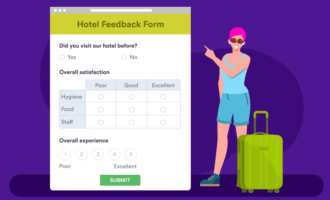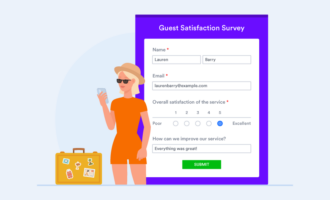What are the different types of polls?
- Opinion poll
- Benchmark poll
- Entrance and exit polls
- Tracking poll
- Push poll
Understanding the thoughts and opinions of a target audience is essential in any industry. From business to politics to education and beyond, organizations often rely on polls to learn what their audience is thinking or feeling.
The art and science of polling can be challenging at times, but one fact remains clear: It takes different types of polls to gather different types of data. In this article, we cover what exactly a poll is, what the different types are, and how you can create a poll online using intuitive software.
What is a poll?
You probably know that a poll is a method of gathering data, consisting of opinions about a particular topic, from a target audience. A less commonly known fact is that what sets a poll apart from other methods of inquiry (such as surveys) is its narrow focus. A poll typically consists of only one question — or maybe a few related to one specific topic.
To learn all the differences between polls and surveys you can check this article out: Poll vs Survey.
Polls also always use closed-ended questions. The respondent doesn’t write in their own answer; they just select an answer from a set group of answers. Polls often include multiple-choice, rating, or yes/no questions.
A wide variety of industries and professions use polls. In politics, for example, polls are important for understanding public opinion about issues or candidates.
In business, polls are essential for developing an understanding of customers’ preferences regarding products, services, and features. They’re also instrumental in determining brand positioning.
In education, their many uses include learning people’s scheduling preferences for important events or their opinions regarding school policy. These are just a few examples of the myriad uses for polls.
What are the different types of polls?
As we’ve established, different types of polls are designed to gather different types of information. Although most polls contain only one question, a poll can contain more than one if the questions are about closely related topics or facets of a single topic.
If you’re planning to create a poll, be sure to consider how your ultimate goal might fit with a particular closed-ended question format. Here are different types of polls you can use to gather the insight you need:
- Opinion poll: As the name suggests, this type of poll is designed to get feedback on an audience’s feelings toward a particular issue. For example, a business may use an opinion poll to learn what type of packaging its customers most prefer, such as plastic, paper, or recycled.
- Benchmark poll: This type of poll is common in politics. It helps to gather initial public opinion on a crucial topic, such as how many people plan to vote for a particular political candidate. It’s also helpful for developing a basic understanding of where the target audience stands. The data guides the formulation and execution of strategy.
- Entrance and exit polls: This is another type of poll you’ll frequently see in politics. Voters respond to these polls before they enter a polling station and after they leave. They’re helpful in ascertaining which candidates or sides of an issue voters support. Entrance and exit polls are also useful to get feedback on pertinent topics at business events.
- Tracking poll: This type of poll repeatedly asks the same question or set of questions over a set interval of time, such as weekly for four months. Depending on the use case, pollsters can either allow the data to accumulate or discard previous intervals’ results when newer data arrives.
- Push poll: While many polls use neutral language in their questions and answers, push polls deliberately use suggestive language that leans toward a specific viewpoint. This is a marketing technique — designed to persuade the target audience to adopt the marketer’s viewpoint — in the guise of a poll.
What’s the ideal solution for creating any type of poll?
Whether you’re looking to create a benchmark poll, opinion poll, or another type of poll, you can craft a highly effective one with Jotform. An intuitive and easy-to-use software, Jotform comes with a wealth of poll templates, so you don’t have to start from scratch.
Each template is fully customizable — from question formats to branding to poll structure — so you can precisely change it to suit your needs. Or you can create a new poll from scratch; Jotform’s drag-and-drop form builder makes it easy.
All polls and responses you create with Jotform will be completely secure, so you won’t have to worry about data breaches. Plus, you can turn the responses into easy-to-understand visual reports using Jotform Report Builder.
Photo by Karolina Kaboompics






































































































Send Comment: